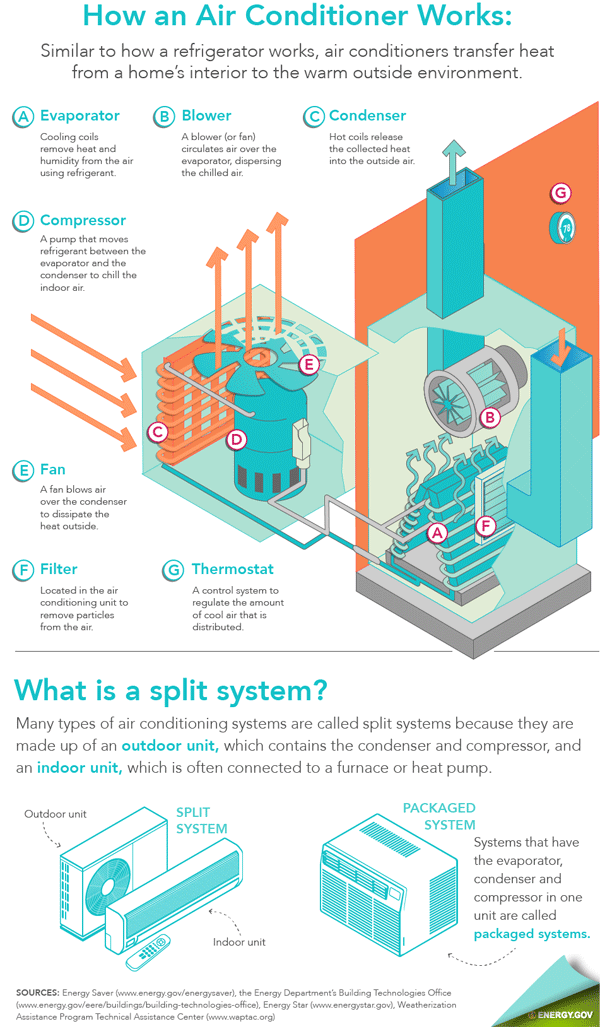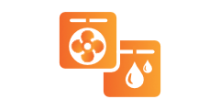Buildings that are properly air sealed and insulated are more efficient to keep cool. Before you install or upgrade a cooling system, you may want to consider consulting a qualified energy professional, who can assess your building's needs with an energy audit. They can also help you make a plan to choose and size a cooling system that best fits your needs. Visit the Weatherization section to learn more about Energy Audits.
Air Conditioners
Air conditioners can help keep humidity and moisture at a healthy level in your building. For air conditioners, you have a choice of “central” units for the entire building or "packaged" units that can be added as needed in individual spaces.
According to Energy.gov, three-quarters of all homes in the United States have air conditioners. Air conditioners employ the same operating principles and basic components as your refrigerator. Refrigerators use energy to transfer heat from the cool interior of the refrigerator to the relatively warm surroundings of your building; likewise, an air conditioner uses energy to transfer heat from the interior of your building to the relatively warm outside environment.
An air conditioner cools your building with a cold indoor coil called the evaporator. The condenser, a hot outdoor coil, releases the collected heat outside. The evaporator and condenser coils are usually copper tubing surrounded by aluminum fins. A pump, called the compressor, moves a heat transfer fluid (or refrigerant) between the evaporator and the condenser. The pump forces the refrigerant through the circuit of tubing and fins in the coils. The liquid refrigerant evaporates in the indoor evaporator coil, pulling heat out of indoor air and cooling your building. The hot refrigerant gas is pumped outdoors into the condenser where it reverts back to a liquid, giving up its heat to the outside air flowing over the condenser's metal tubing and fins.
The two most common types of air conditioners are room air conditioners and central air conditioners. A compromise between the two types of systems is provided by ductless, mini-split air conditioners.
High-efficiency heat pumps can provide both heating and cooling options, though they may not always be the right choice for every situation. If you heat and cool with electricity, you may want to learn more about this technology by visiting the Heat Pump page.
When choosing between "central" or "packaged" air conditioners, consider the amount of floor or operable window space taken up by "portable" or "window" air conditioning units. On the other hand, installing central air conditioning systems and heat pumps can be expensive and you should consider whether it will give you the return on investment you need. Many air conditioners come with built-in "efficient" and "fan" modes as well. When shopping for systems, ask your retailer or contractor about properly sizing your system and about how much a system costs to purchase, install and operate.
Fans
During moderately warm weather, fans may allow you to avoid using your air conditioner altogether. Fans generally fall into two categories:
- Circulating Fans: Circulating fans include ceiling fans, table fans, floor fans, and fans mounted to poles or walls. According to energy.gov, these fans create a wind chill effect that can make you more comfortable in your building. Ceiling fans are considered the most effective of these types of fans, because they circulate the air to create a draft throughout the room. Typically, a fan is installed in each room that needs to be cooled during hot weather and turned off when you leave.
Larger ceiling fans can move more air than smaller fans, however the size and shape of your building will determine what size and how many fans are appropriate. For example, small and medium-sized fans will provide efficient cooling in a 4- to 6-foot diameter area, while larger fans are effective up to 10 feet, and ceiling fans are only appropriate in rooms with ceilings at least eight feet high. A larger blade will also provide comparable cooling at a lower velocity than a smaller blade, which may be important to consider in areas where loose papers or other objects will be disturbed by a strong breeze. In addition, you may want to consider fitting the fan to the aesthetics of the room, as a large fan may appear overpowering in a small room. You may also want to check the noise rating, and, if possible, listen to the fan in operation before you buy it.
- Window Fans: Window fans typically use little energy and can provide effective cooling. Window fans are best used in windows facing away from the prevailing wind to exhaust hot air from your building. To cool as much of your building as possible, tightly close windows near the fan and open windows in rooms far from the fan. Windows near shaded outdoor areas generally provide the best intake air. In multi-level buildings, the fan should be located on the upper level, if possible, and the open windows should be located on a lower level. If that's not practical, you may want to ventilate each level of your building with separate fans. Depending on the layout, you might want to use multiple window fans working together to pull air through your building. For instance, fans in several upstairs bedrooms can help cool each bedroom and work together to move air through the rest of a home.
Regardless of which fan you choose, look for the ENERGY STAR® label. Fans that earn the label move air 20% more efficiently, on average, when compared to standard models. You can learn more about fans by visiting the ENERGY.GOV Home Cooling Systems page.
Some Cooling Tips
- During the summer, keep window coverings closed during the day to block the sun's heat
- If you use air conditioning, a ceiling fan may allow you to raise the thermostat setting about 4°F with no reduction in comfort
- Clean or replace filters on air conditioners once a month or as recommended
- Select energy-efficient products when buying new cooling equipment. Your contractor should be able to give you energy fact sheets for different types, models, and designs to help you compare energy usage.
- Set programmable thermostats as high as is comfortable in the summer, and raise the setpoint when sleeping or away from your home or office
- During warmer summer months, set a ceiling fan to run in the counterclockwise direction. The airflow directly underneath the fan should move downward, creating a wind chill effect that will help make a person feel cooler. During colder winter months, reversing the fan direction to a clockwise rotation creates a gentle updraft, recirculating warm air downward.
Here are some more cooling tips from the Department of Health:
- Close windows during the day when it is hotter outside than inside
- Open windows at night when it's cooler outside than inside
- Limit use of the stove, oven and other heat-generating appliances
Some Next Steps
You can visit the following links at energy.gov to learn more about Cooling:
You can also visit the following link to learn more about the current line-up of ENERGY STAR® certified heating & cooling products:
Learn More
Visit the pages below to learn more about Heating & Cooling:







